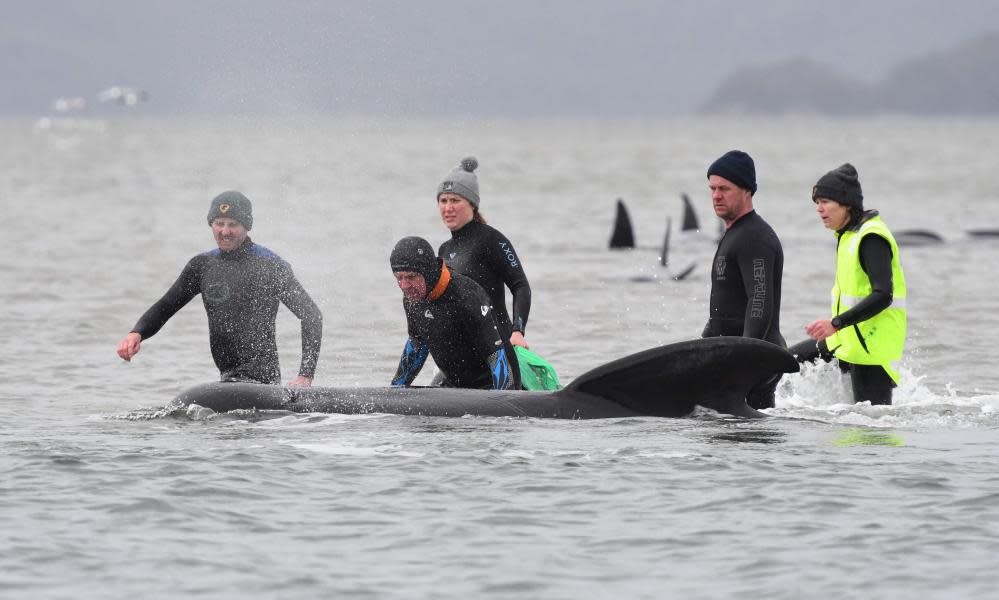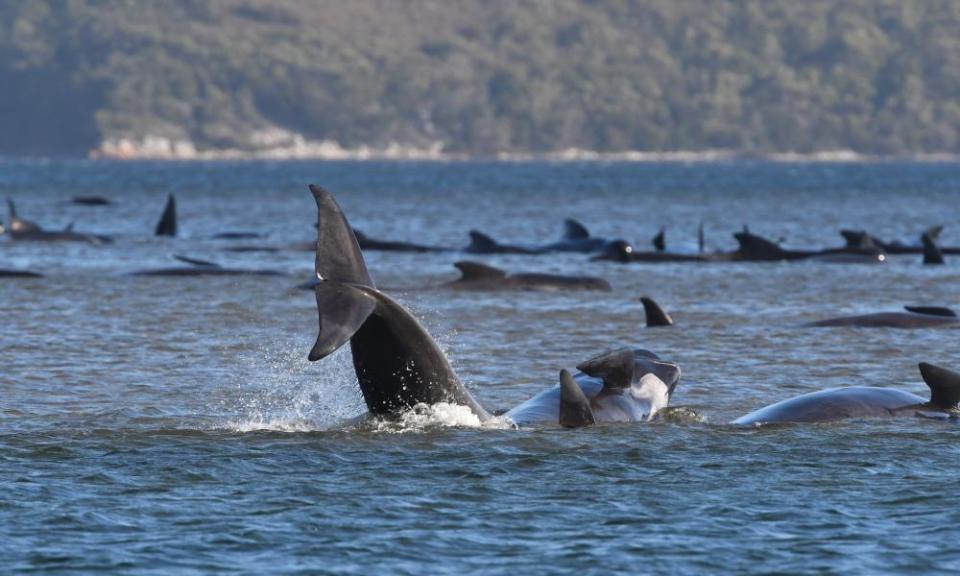Australia whales: rescuers in Tasmania free 25 stranded pilot whales, but 90 already dead

Rescuers have freed 25 of the 270 whales stranded on Tasmania’s west coast with the state government confirming about 90 of the marine mammals have already died.
A huge rescue effort got under way near Strahan in Macquarie Harbour on Tuesday morning, with 60 people and several boats trying to free the marine mammals stuck on two sandbanks and a beach.
The coordinator of the rescue, Parks and Wildlife Service regional manager Nic Deka, has told Guardian Australia of the daunting task ahead after first seeing the long-finned pilot whales from the air.
Deka said the first rescues of the morning involved staff and volunteers up to chest deep in the water.
Related: Rescuers scramble to save stranded pilot whales in Tasmania, with up to 90 feared dead
“We’ve hit upon a method that’s giving us the best chance of success,” he said. Rescuers put a large sling under the whale and then pull and coax the animal off the sand.
“There comes a point when the whale becomes slightly buoyant then we allow the boat to help the whale into the channel and the animal is then released.”
He said it was a 30-minute round trip for each animal, as they needed to be taken far enough away from the other stranded whales so that they didn’t just turn around and swim back.
“It’s just a matter of steering them. These animals have been in a reasonable shape. They tend to want to return to the pod – they’re very social – so we have to get them far enough away.”
On Tuesday afternoon, Deka’s team had rescued 25 whales.
Late on Monday, Deka surveyed the stranding from a helicopter. “It’s a bit disturbing and distressing to see that number of animals stuck and in trouble,” he said.
“My role is an incident controller and it was quite daunting as I started to get an appreciation of the task ahead.”

With about 90 animals already dead, Deka said they were starting on plans to dispose of the carcasses as some were close to areas used by the public.
Australia’s national science agency, the CSIRO, was advising on ocean currents that could be used to move the dead animals out to the ocean. A landfill could also be used, but this was “not without its problems”, he said.
Long-finned pilot whales can weigh well over a tonne, with some about the weight of a small family car.
Deka said no dead animals had been moved yet as the focus was on freeing the survivors. The rescue effort is likely to last at least several days.
Tasmania’s west coast is exposed to changeable and wild weather. A high tide was approaching and a low-pressure system in the area over the next two days could also push water levels in the harbour higher.
This could theoretically free some of the whales, Deka said, but the problem could be that they would not swim out beyond Macquarie Heads and into the ocean.
He said: “The problem is that they return to the animals that are in distress. Our assessment is that if they are free, they are unlikely to head out unless we give them some assistance.”
Tasmania’s coastline, and Macquarie Harbour, have seen many strandings of whales.
The rescue is being coordinated by the state’s Department of Primary Industries, Parks, Water and Environment.
As well as 40 departmental staff, another 20 volunteers are also helping, mainly from the harbour’s fish farming industry.
Deka added: “It’s certainly a challenging task and you need people not just trained and competent in whale rescue, but are also quite proficient in the water. These are quite stoic individuals – we have some very experienced people involved.
“With these events there’s generally mortality [of the animals] and it’s sad, but it’s not unfamiliar [to the rescuers].”
Dr Kris Carlyon, from the department’s Marine Conservation Program which is carrying out the rescue, said it was hard to know why strandings happened.
He told reporters on Tuesday morning: “We have had multiple mass strandings of pilot whales and sperm whales at a similar location.
“It could be they are being drawn into this area by feeding closely to the coast, but it could be simply misadventure by one or two animals.
“Pilot whales are such a social species they could draw the rest of the group in, but we just don’t know.”
Carlyon said the stranding was the “trickiest” he’d had to deal with in his 12 years with the program, with tides, sand, weather and scale all making the rescue effort a challenge.

 Yahoo News
Yahoo News 
